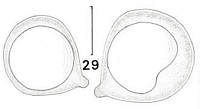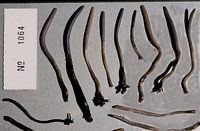|
 Clavaria plumbeoargillacea Clavaria plumbeoargillacea
BiostatusPresent in region - Indigenous. Endemic
Images (click to enlarge)
Caption: Fig. 29 Clavaria plumbeo-argillacea. spores. Horak no. 1064 (ZT). Scale bar=5 µm. | 
Caption: Microfiche 1-22. Clavaria plumbeo-argillacea. Horak no. 1064. |
Article: Petersen, R.H. (1988). The clavarioid fungi of New Zealand. New Zealand Department of Scientific and Industrial Research, Bulletin 236: 170 pp. Wellington:.
Description: Fruit bodies up to 80 x 4 mm, simple clubs, solitary to gregarious but not cespitose or
fasciculate, "at first grey, pale blue-grey, turning to pale argillaceous with age" (teste Horak
annotation). Stipe rounded at base, with no basal mycelial pad, terete, appearing silky, up to
30 x 3 mm, clearly distinguishable from club. Club terete to longitudinally wrinkled or
sulcate, appearing waxy; apex rounded.
Tramal hyphae of club 3-12 µm diam., inflated, clampless, thin-walled, hyaline, free,
parallel. Subhymenium extensive, pseudoparenchymatous. Hymenium thickening; basidia
90-105 x 13-15 µm, clavate, with a long, equal stalk portion and abruptly flaring apex,
asymmetrically bifurcate to clamped; contents obscurely refringent when mature to granular;
sterigmata 4, up to 10 µm long, curved-ascending to curved-divergent.
Spores (Fig. 29) 8.3-10.4 x 7.9-9.7 µm (E = 1.00-1.16; Em = 1.09; Lm = 9.58 µm), globose to
subglobose, thin-walled, smooth; contents uniguttulate when mature; hilar appendix short,
broad, papillate.
Notes: Again, I have only two specimens, but also a good photograph, colour sketch, and notes.
Superficially, fruit bodies must resemble those of some Cordyceps, being very terete and
straight. Colours are, of course, reminiscent of Clavaria muscula (smaller spores, no
argillaceous shades) and C. ardosiaca (higher P" value, no argillaceous shades, and usually
fasciculate fruit bodies).
|